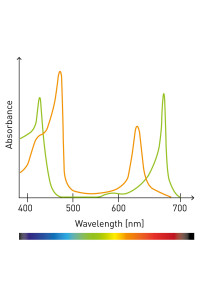UV-VIS Resveratrol Content Measurement
- Product Code: 32525
UV-VIS Resveratrol Content Measurement
Measuring the resveratrol content in a sample using UV-Vis (Ultraviolet-Visible) spectroscopy is a common and reliable analytical technique. Resveratrol is a natural compound found in grapes, red wine, and some other plants, known for its potential health benefits. UV-Vis spectroscopy works based on the principle that molecules absorb light at specific wavelengths, and this absorption can be used to quantify the concentration of a substance in a sample.
Materials and Equipment:
UV-Vis spectrophotometer
Resveratrol standard solution (of known concentration)
Sample containing resveratrol
Appropriate cuvettes or glass vials
Solvents (typically ethanol or methanol)
UV-Vis spectroscopy software
Procedure:
Preparation of Standard Solutions:
Prepare a series of standard solutions of resveratrol with known concentrations. These standards will be used to create a calibration curve.
Sample Preparation:
Extract or prepare sample containing resveratrol. If the sample is a solid, you may need to extract the resveratrol using an appropriate solvent (e.g., ethanol or methanol). Ensure that the sample is properly homogenized and filtered if necessary.
Blank Solution:
Prepare a blank solution using the same solvent used for the standards and sample. This blank will be used to zero the spectrophotometer.
Instrument Setup:
Turn on the UV-Vis spectrophotometer and allow it to warm up.
Set the wavelength to the appropriate range for resveratrol absorption, which is typically around 306-308 nm.
Calibrate the instrument using the blank solution.
Measurement:
Measure the absorbance of the blank solution at the chosen wavelength to zero the instrument.
Measure the absorbance of each standard solution and sample at the same wavelength.
Calibration Curve:
Plot a calibration curve with absorbance (y-axis) against the concentration of resveratrol standards (x-axis). The curve should be linear.
Use this calibration curve to determine the concentration of resveratrol in sample based on its absorbance.
Calculations:
Calculate the resveratrol content in sample using the calibration curve equation.
| ขั้นตอน | ขั้นตอน | ผลลัพธ์ที่คาดหวัง |
|---|---|---|
| 1 | 50... |
1000µg/ml concentration of standard solution. |
| 2 | The standard... |
Appropriate concentrations of Resveratrol solution within the linearity range |
| 3 | The solution... |
Obtaining the value of maximum absorbance at 325 nm wavelength. |
| 4 | The... |
Appropriate concentration of the tested sample within the linearity range. |
| 5 | The resveratrol content... |
The value of Resveratrol content in the formulation(ug/ml) . |
คุณจะได้รับรายงานสำหรับ Concentration of Resveratrol (ug/ml) ฟิลด์เมื่อเราให้บริการนี้
UV-VIS Resveratrol Content Measurement
Measuring the resveratrol content in a sample using UV-Vis (Ultraviolet-Visible) spectroscopy is a common and reliable analytical technique. Resveratrol is a natural compound found in grapes, red wine, and some other plants, known for its potential health benefits. UV-Vis spectroscopy works based on the principle that molecules absorb light at specific wavelengths, and this absorption can be used to quantify the concentration of a substance in a sample.
Materials and Equipment:
UV-Vis spectrophotometer
Resveratrol standard solution (of known concentration)
Sample containing resveratrol
Appropriate cuvettes or glass vials
Solvents (typically ethanol or methanol)
UV-Vis spectroscopy software
Procedure:
Preparation of Standard Solutions:
Prepare a series of standard solutions of resveratrol with known concentrations. These standards will be used to create a calibration curve.
Sample Preparation:
Extract or prepare sample containing resveratrol. If the sample is a solid, you may need to extract the resveratrol using an appropriate solvent (e.g., ethanol or methanol). Ensure that the sample is properly homogenized and filtered if necessary.
Blank Solution:
Prepare a blank solution using the same solvent used for the standards and sample. This blank will be used to zero the spectrophotometer.
Instrument Setup:
Turn on the UV-Vis spectrophotometer and allow it to warm up.
Set the wavelength to the appropriate range for resveratrol absorption, which is typically around 306-308 nm.
Calibrate the instrument using the blank solution.
Measurement:
Measure the absorbance of the blank solution at the chosen wavelength to zero the instrument.
Measure the absorbance of each standard solution and sample at the same wavelength.
Calibration Curve:
Plot a calibration curve with absorbance (y-axis) against the concentration of resveratrol standards (x-axis). The curve should be linear.
Use this calibration curve to determine the concentration of resveratrol in sample based on its absorbance.
Calculations:
Calculate the resveratrol content in sample using the calibration curve equation.
| Mechanism | - |
| Appearance | - |
| Longevity | - |
| Strength | - |
| Storage | - |
| Shelf Life | - |
| Allergen(s) | - |
| Dosage (Range) | - |
| Recommended Dosage | - |
| Dosage (Per Day) | - |
| Recommended Dosage (Per Day) | - |
| Mix Method | - |
| Heat Resistance | - |
| Stable in pH range | - |
| Solubility | - |
| Product Types | - |
| INCI | - |
| Step | Procedure | Expected Result |
|---|---|---|
| 1 | 50... |
1000µg/ml concentration of standard solution. |
| 2 | The standard... |
Appropriate concentrations of Resveratrol solution within the linearity range |
| 3 | The solution... |
Obtaining the value of maximum absorbance at 325 nm wavelength. |
| 4 | The... |
Appropriate concentration of the tested sample within the linearity range. |
| 5 | The resveratrol content... |
The value of Resveratrol content in the formulation(ug/ml) . |
Purchase History for
ตะกร้า
ไม่มีสินค้า



